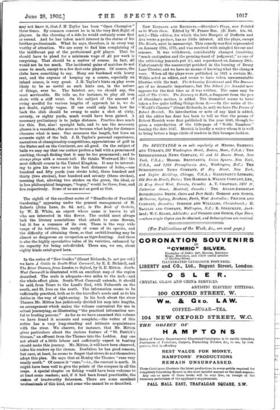In the series of "New Guides" (Grant Richards, 2s. net
per vol.) we have A Guido to South-West Cornwall, by E. E. Bicknell, and The River Thames, from London to Oxford, by G. E. Mitten. South- West Cornwall is illustrated with an excellent map of the region described. The scale is adequate—two miles to the inch—and the whole effect plain. South-West Cornwall extends, it should be said, from Truro to the Land's End, with Falmouth on the south, and St. Ives on the north. The information seems to be sufficiently practical, both as to the traveller's needs and as to his duties in the way of sight-seeing. In his book about the river Thames Mr. Mitton has judiciously divided his map into lengths, an arrangement which makes the volume convenient for use in actual journeying, as illustrating "the practical information use- ful to boating persons." As far as we have examined this volume we have found it accurate and complete,—the writer of this notice has a very long-standing and intimate acquaintance with the - river. We observe, for instance, that Mr. Mitten gives particulars about the curious feature of " St. Patrick's Stream," an effluent from the Thames into the Loddon. Any one not afraid of a little labour and sufficiently expert in boating should make this journey. Mr. Mitton, it will have been observed, takes his readers up the stream. Doubtless he has good reasons, but once, at least, he seems to forget that rivers do not themselves adopt this plan. He says that at Henley the Thames "runs very nearly south." Of course it "runs,"—i.e., the current is north. It might have been well to give the points of the compass in all the maps. A special chapter on fishing would have been welcome to at least some readers; and, if it had been found practicable, the flakes of trustworthy fishermen. There are some excellent tmefessionsla of this kind, and some who cannot be so described.


















































 Previous page
Previous page